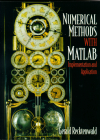
with MATLAB:
Implementations
and Applications
Gerald Recktenwald
© 2000, Prentice Hall
ISBN: 0201308606

|
Numerical Methods with MATLAB: Implementations and Applications Gerald Recktenwald © 2000, Prentice Hall ISBN: 0201308606 |
Cover Photo |
| Clock Info | m-files | errata | NMM Home |
The image on the cover of the book is from a photograph of an astronomical clock made by Rasmus Sørnes between 1958 to 1964. The clock is in the collection of the Time Museum, which in 1999 was acquired by the Chicago Museum of Science and Industry.
I found out about this clock when a colleague, Wendell Meuller, showed me the Fall 1992 issue (Volume 8/Number 2) of American Heritage of Invention and Technology Magazine (ISSN 8756-7296). I was talking to Wendell about my plan to put an image of a clock on the cover of my book. Shortly thereafter, Wendell returned with a copy of the magazine, which contained many dazzling images of timekeeping masterpieces.
To me, a clock is a wonderful example of the numerical computations that are important to engineers: it is practical, it involves a model of our natural world (the motion of the earth around the sun) and it is an enabling technology. Handmade mechanical clocks appeal to me because they are a work of dedicated craftsmanship. (And because I am a mechanical engineer!) An accurate mechanical clock is the work of an artisan who has obtained precision while dealing with limitations (friction, thermal expansion, mechanical tolerances). So too, the numerical craftsman produces a work of practical utility, that enables modeling of physical reality, and that obtains precision only by managing the limitations of roundoff and truncation error.
The image of the Sørnes clock caught my attention by its beauty: the symmetrically arranged dials, and the delicate globes with the images of the earth and gilded figures of the zodiac. Equally impressive is the intricacy of its computation: it counts hours, days, months, and years. It automatically adjusts for leap years, while allowing for the exception that years divisible by 100 have no leap year unless they are also divisible by 400. Furthermore the clock keeps track of the motion of all the planets, it predicts solar eclipses, and it indicates the progress of the earth's precession on its axis. Note to students: my appreciation of the Sørnes clock should not be construed as an endorsement of rococo programming style.
For more information see